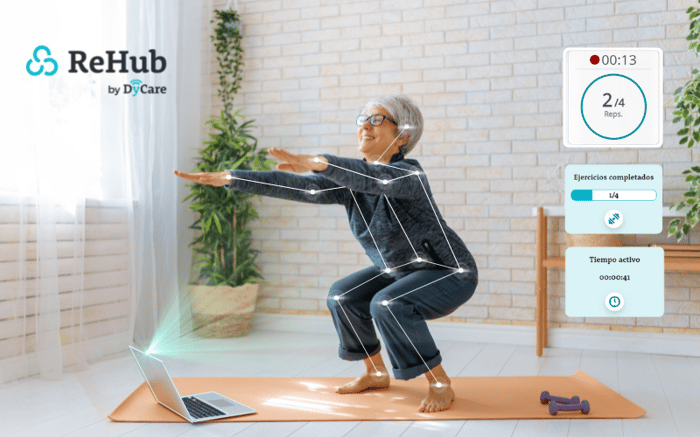- What is Computer Vision
- What does Computer Vision measure?
- What are the benefits of using Artificial Intelligence in rehabilitation?
Artificial Intelligence is revolutionizing the world! In the last month, it has become clear that artificial intelligence is here to stay and transform the way we live and work. Proof of this is the rise in use and popularity of tools such as Dalle-2 and ChatGPT. These technological advances are changing the game in a variety of industries, and it's exciting to see what the future holds with this technology!
The truth is that this tool can help us make more efficient decisions, automate routine tasks and create new opportunities and experiences. The fields of artificial intelligence are varied and range from natural language processing, robotics and camera-based motion detection.
During the COVID pandemic we saw many computer solutions that talked about recognising body movement using "computer vision", but what does this mean for Computer Vision? What are its limitations?
What is Computer Vision?
It is a rapidly growing field of artificial intelligence (AI) research that focuses on teaching computers to "see" the world around them. Camera motion detection technology, or computer vision, focuses on acquiring, analyzing and understanding digital images and videos. This technology can be used to automatically detect and identify objects and people, track their movements and recognise patterns.
It has already been used to create self-driving cars, facial recognition systems and even medical diagnostic software.
Artificial intelligence (AI) has revolutionized the healthcare sector and it was only a matter of time before it did so in the practice of physiotherapy. Researchers have been using camera detection to help people with disabilities and injuries recover for years.
However, it is only since the advent of the latest smartphones that it has become popular.
Computer Vision technology involves using camera detection algorithms to track a patient's progress during physiotherapy and other rehabilitation tasks. The aim is to provide information to the therapist and patient in real time and to be able to monitor the patient's progress towards regaining function.
Telerehabilitation platforms with Computer Vision can be used to generate reports for the physician or physiotherapist, providing them with valuable information about the patient's progress. By providing critical information about the patient's performance, therapists can better tailor exercises to the patient's individual needs.
The success of this technology is largely due to the availability of increasingly powerful devices, such as smartphones, which have computational features and high-resolution cameras that allow this process to be carried out in a way that is transparent to the user.
What does camera detection measure?
How does "computer vision" recognise the human body and its pose? How do machines understand human movement when there are so many variables involved?
In the world of computer vision, the human body is one of the most unpredictable elements. But there is an area of computer vision that deals with identifying and predicting the position and orientation of a human body within a given image or video frame. Human pose estimation is the science of identifying where all parts of a person's body are in relation to each other and to the surrounding environment.
In physiotherapy, computer vision can be used to analyze a patient's posture, range of motion and gait. One of the most promising applications of computer vision in physiotherapy is the use of a platform that can track a patient's progress over time.
DyCare has created ReHub, a digital rehabilitation platform that allows users to follow the patient during the execution of their exercises and assists the professional in monitoring them. ReHub has a library of AI-guided exercises that use High Performance Computing science, allowing it to provide true real-time feedback to the patient on how they are performing the exercises, correcting errors and congratulating the patient when they perform them correctly. These features help rehabilitation professionals provide a level of care that is as efficient and personalized as if the physiotherapist were in the patient's own home.

Benefits of using camera vision in rehabilitation
- Increased diagnostic accuracy: Computer vision can help physiotherapists identify and diagnose problems more accurately.
- Better patient follow-up: By using computer vision, physiotherapists can follow their patients more closely and identify potential problems.
- Reduced diagnostic time: Computer vision can reduce the amount of time required for diagnosis, as it can detect irregularities quickly and accurately.
- Improved patient experience: Computer vision can provide a more personalised experience for patients, as it can tailor treatment plans to each individual.
- Increased safety: Computer vision can help reduce the risk of injury and other health problems by more closely monitoring the patient's movements.
- Reduced costs: Computer vision can help reduce costs by providing an efficient solution for diagnosis and treatment.
Other applications of camera-sensing based rehabilitation include amputees, spinal cord injury rehabilitation and even postural control. Computer vision-based rehabilitation has the potential to revolutionize the way physical ailments are treated.
-1.png?width=700&height=350&name=Dise%C3%B1o%20sin%20t%C3%ADtulo%20(6)-1.png)
.png?width=1092&height=497&name=RehubbyDycare_cobalto%20(4).png)